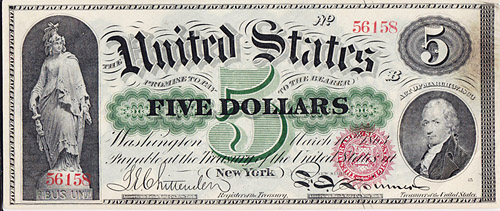
PREV ARTICLE
NEXT ARTICLE
FULL ISSUE
THE BIRTH OF THE GREENBACK
Even the most widely known currencies have an origination story. Pablo Hoffman forwarded this article on "The Birth of the Greenback" from "Disunion," the ongoing series in The New York Times on the events surrounding the Civil War. Thanks! here's an excerpt, but he sure to read the complete article online.
-Editor

Image from the Museum of American Finance: www.moaf.org On Dec. 30, 1861, Elbridge Gerry Spaulding, the chairman of the House Ways and Means Subcommittee on Banking and Currency, gave a speech on the House floor declaring that the nation was “never in greater peril than at this moment.” The Civil War was eight months old, but Spaulding’s concern wasn’t martial, but fiscal. Federal expenditures to support the war effort were growing significantly; at the same time, revenues were stagnant – revenues produced by the federal income tax could not even cover the interest on the federal debt, which was rising at a vertiginous rate. To make matters worse, two days before Spaulding addressed his colleagues, the nation’s banks decided to suspend payments in gold and silver, which at the time were the only universally accepted means of payment; as a result, the federal government faced the prospect of being unable to make good on existing commitments. It was under these dire circumstances that Spaulding introduced what he called a “war measure” and a “measure of necessity”: a bill that authorized Treasury Secretary Salmon P. Chase to issue $150,000,000 in paper notes as “lawful money and a legal tender in payment of all debts, public and private, within the United States.” These United States Notes – informally called “greenbacks,” as they were printed with green ink – were not backed by specie. Spaulding explained that the “leading object” of the bill was “to fund the debt” and to “meet the most pressing demands upon the treasury to sustain the Army and Navy until they can make a vigorous advance upon the traitors and crush out the rebellion.” Government-issued currency was a radical proposition, he admitted. But, he concluded, “These are extraordinary times and extraordinary measures must be resorted to, in order to save our Government.” Secretary Chase reluctantly endorsed the bill, acknowledging that the situation had become “indispensably necessary that we should resort to the issue of United States notes.” Passed by Congress and signed into law by President Lincoln, the Legal Tender Act was enacted on Feb. 25, 1862. Today Treasury-issued notes are a ubiquitous feature of modern society.
To read the complete article, see:
The Birth of the Greenback
(opinionator.blogs.nytimes.com/2013/12/31/the-birth-of-the-greenback/)
The Numismatic Bibliomania Society is a non-profit organization promoting numismatic literature. See our web site at coinbooks.org. To submit items for publication in The E-Sylum, write to the Editor at this address: whomren@gmail.com To subscribe go to: https://my.binhost.com/lists/listinfo/esylum All Rights Reserved. NBS Home Page Contact the NBS webmaster 
|